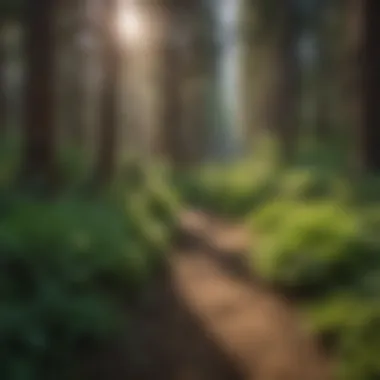Discover Bend, Oregon's Premier Hiking Trails


Intro
Bend, Oregon, is a location that beckons those who appreciate nature and seek adventure. The trails here wind through diverse landscapes that offer not only breathtaking views, but also a unique chance to learn about sustainable practices in forestry. In this article, we will explore the best hiking trails in Bend while emphasizing the importance of conservation and stewardship of natural resources. This guide is crafted for forestry professionals and nature enthusiasts alike, providing insights into the ecological significance of each area and promoting responsible hiking habits.
Overview of Forestry Practices
Forestry plays a vital role in maintaining ecological balance. It encompasses the management of forests, which includes trees, wildlife, and the associated ecosystems. This section provides a foundation for understanding how hiking trails in Bend relate to broader forestry practices.
Definition of Forestry
Forestry involves the cultivation and management of forests to meet diverse human needs while conserving biodiversity and the environment. This aspect makes it integral to ecosystem management.
Importance of Forestry in Ecosystem Management
Sustainable forestry is crucial for preserving habitats, ensuring air quality, and regulating water cycles. In areas like Bend, effective forestry practices support trail systems that allow people to enjoy nature while minimizing their ecological footprint.
Sustainable Forest Management
Understanding sustainable forest management principles is essential for anyone using these trails. Hiking responsibly enhances the natural experience while protecting the landscape.
Principles of Sustainable Practices
Sustainable forest management focuses on long-term health of forests. This involves balancing social, economic, and environmental goals. Key principles include:
- Maintaining biodiversity
- Protecting water quality
- Ensuring forest health
- Promoting community engagement
Techniques in Sustainable Management
Practices such as selective logging, controlled burns, and habitat restoration are critical. These techniques aim to maintain forest vitality and allow for effective recreation facilities, enhancing both the visitor experience and ecosystem resilience.
Woodland Stewardship Strategies
Woodland stewardship involves proactive measures taken to enhance land management. Understanding these strategies is particularly relevant for landowners and those hiking in areas where stewardship is a focus.
Importance of Woodland Stewardship
Stewardship ensures that land remains viable for future generations. Practices also encourage community involvement in forest care, which can influence policy and funding for conservation efforts.
Best Practices for Landowners
Landowners play a key role in shaping the health of woodland ecosystems. Best practices include:
- Regular assessment of forest health
- Implementing wildlife-friendly measures
- Promoting native species over invasive ones
- Encouraging educational programs for the community
"Sustainable forestry is not just about trees. It's about the entire ecology that surrounds us and the principles that guide our interaction with these spaces."
In exploring the best hiking trails in Bend, it becomes clear that understanding these principles of forestry adds depth to the experience. By adopting sustainable hiking habits and respecting woodland stewardship, we not only enjoy the trails but also contribute positively to the environment.
Prelims to Hiking in Bend
Bend, Oregon is known for its stunning landscapes and diverse hiking possibilities. This section introduces the reader to the hiking opportunities that Bend offers, while highlighting its unique geographical and climatic features. Hiking in this region is not just an outdoor activity; it is a way to connect with nature and alleviate stress. It also provides a chance for education on the local ecology. Understanding the context of hiking in Bend is important to fully appreciate what it has to offer, including its challenges and rewards.
Geographical Context
Bend is nestled between the high desert and the Cascade Mountains, making it a unique location for a variety of hiking trails. The area is characterized by its mixed forests, rocky landscapes, and clear lakes. Mount Bachelor and the Three Sisters are prominent features that attract hikers. Trails such as those in the Deschutes National Forest often provide panoramic views of the surrounding natural beauty. Hiking here allows for exploration of diverse ecosystems ranging from volcanic landscapes to lush riverbanks.
This geographical diversity makes Bend one of the premier hiking destinations in the Pacific Northwest. The interplay of location and landscape creates opportunities for various hiking experiences, from short walks to challenging multi-day treks.
Climate Considerations


The climate of Bend plays a crucial role in hiking conditions. Typically, Bend has a high desert climate with dry summers and cold winters. Summer temperatures can reach into the 90s Fahrenheit, making it pleasant for day hikes. However, hikers should be prepared for rapidly changing weather patterns. Winter brings snow and freezing temperatures, which can transform trails and require special gear.
Autumn provides mild temperatures and a beautiful display of fall colors, offering another opportunity for hikers. Understanding these climate patterns is essential for preparing adequately, ensuring safety, and enhancing the overall hiking experience. It is advisable to check local weather forecasts and be aware of trail conditions before heading out.
"Hiking in Bend provides a unique opportunity to engage with diverse ecosystems while also posing the challenge of adapting to varying climatic conditions."
Knowing the geographical and climatic factors at play not only enriches the hiking experience but also underscores the importance of safety and preparation.
Understanding Sustainable Hiking
Sustainable hiking is essential in preserving the natural beauty and ecological integrity of regions like Bend, Oregon. This section explores how the practice of sustainable hiking benefits both the environment and the hiking community. With increasing foot traffic in popular hiking areas, understanding sustainable practices becomes vital for maintaining these natural landscapes.
One key element of sustainable hiking is ensuring minimal impact on the environment. This practice encourages hikers to engage with nature without compromising its health. By adopting sustainable habits, hikers can help preserve local flora and fauna. This also promotes a more enjoyable experience, as fewer disturbances create a serene atmosphere for all.
Leave No Trace Principles
Leave No Trace is a set of principles designed to promote responsible outdoor ethics. It guides hikers to minimize their impact on nature. Here are the seven principles that every hiker should follow:
- Plan ahead and prepare: Proper planning reduces the likelihood of accidents and helps manage resources.
- Travel and camp on durable surfaces: Stick to established trails and campsites to avoid damaging vegetation.
- Dispose of waste properly: Carry out all waste, including food scraps, to prevent polluting the environment.
- Leave what you find: Preserve the natural environment by not removing plants or historical artifacts.
- Minimize campfire impact: Use a camp stove instead of fires when possible, and adhere to local regulations.
- Respect wildlife: Observe animals from a distance and do not feed them, as it can harm their behavior and health.
- Be considerate of other visitors: Keep noise levels down and share the trails with others to enhance everyone's experience.
By adhering to these principles, hikers help maintain the natural ecosystems of Bend.
Environmental Impact of Hiking
Hiking can cause various environmental impacts if not practiced sustainably. Increased foot traffic can lead to soil erosion, damage to plant life, and disturbances to wildlife habitats. Understanding these issues helps hikers recognize their responsibility in maintaining the environment.
Some areas in Bend have specific ecological concerns. For example, repeated trampling can create bare soil, which not only affects plant life but also increases runoff, leading to water quality issues in nearby streams and rivers.
Conversely, responsible hiking practices can enhance the positive aspects of outdoor activities. Trails can serve as important corridors for wildlife. These paths facilitate the movement of species, helping to maintain biodiversity. Moreover, trails designed with sustainability in mind can help mitigate ecological damage.
By being aware of and addressing the environmental impact of hiking, we can better protect the remarkable landscapes of Bend. This knowledge promotes not only preservation but a deeper connection to the natural world.
Top Hiking Locations in Bend
Bend, Oregon, is celebrated for its stunning landscapes and diverse hiking trails. These trails offer not only recreational opportunities but also serve as vital spaces for environmental conservation. Engaging with the natural beauty found here allows outdoor enthusiasts to connect with the ecosystem unique to Central Oregon. Understanding the top hiking locations enriches the hiking experience and promotes responsible interaction with the environment.
Pilot Butte State Scenic Viewpoint
Trail Difficulty
The Trail Difficulty at Pilot Butte varies depending on the chosen route. This aspect is important as it allows hikers of different skill levels to participate. The main path is around one mile, with a steady incline. Many find this moderate challenge rewarding due to panoramic views you obtain at the summit. It is also excellent for families looking for a short hike that is not too hard. However, some might find it challenging during summer heat, needing to manage their pace and hydration.
Ecological Significance
The ecological significance of Pilot Butte is tied to its unique volcanic landscape and diverse plant communities. This area acts as a volcanic butte, showcasing the geological history of the region. It features various flora, which provides habitat for local wildlife. Educating visitors about this significance encourages respect for the environment while enjoying these natural spaces. Despite its popularity, certain trail areas may show signs of wear from heavy foot traffic, highlighting the need for conservation awareness among hikers.
Sparks Lake and the Deschutes River
Waterfront Trails
Waterfront Trails along Sparks Lake and the Deschutes River allow hikers to experience aquatic ecosystems. These trails are often flat and well-maintained, offering accessibility to all types of hikers. The scenic vistas along the water create a serene atmosphere, perfect for reflective moments. Popular among families, these trails can become busy during weekends, leading to a potential loss of tranquility, yet they are still a favored choice due to their beauty and ease of access.
Biodiversity Considerations
Biodiversity considerations in this area are significant. The blend of wetland and forest habitats supports a variety of wildlife. Observing birds, fish, and other animals contributes to a rewarding experience. Visitors are often reminded to respect wildlife, especially nesting or foraging species. Unfortunately, human activities sometimes pose challenges to maintaining this balance, necessitating ongoing efforts to protect these natural habitats.
Smith Rock State Park
Trail Features
Smith Rock State Park is known for its dramatic rock formations and rugged terrain. The trail features vary from flat and wide paths to steep and rocky trails, appealing to different hiking preferences. Experienced climbers often use routes here, adding excitement to the hiking experience. However, this park can be challenging for novice hikers, requiring proper footwear and preparation, making it essential to choose trails that match your abilities.


Conservation Practices
Conservation practices in Smith Rock are vital due to heavy visitor numbers. The area is part of a broader ecological system that requires stewardship. Local organizations actively promote sustainable practices, including minimizing trail widening and preserving natural sites. Engaging with these initiatives is crucial for the future availability of these natural recreational spaces. Yet, the challenge lies in balancing visitor enjoyment with ecological integrity, prompting ongoing community discussions and education efforts.
Shevlin Park
Woodland Ecosystems
Woodland ecosystems within Shevlin Park thrive with biodiversity. The park preserves a variety of trees and other flora, offering both beauty and ecological importance. Hikers may encounter different habitats as they traverse through the park, creating diverse experiences. This variety enhances interest for those exploring its trails. However, with increased foot traffic, careful planning is needed to avoid habitat disturbance.
Visitor Guidelines
Visitor guidelines in Shevlin Park are essential to maintain the area’s health. Staying on marked trails helps protect sensitive ecosystems. Additionally, rules about trash disposal and wildlife interactions are outlined to ensure ethical hiking practices. Following these guidelines not only enhances the experience but also fosters a community committed to preserving this unique environment. Ignoring these guidelines can lead to erosion and habitat loss, which emphasizes the necessity of responsible hiking.
Deschutes National Forest Trails
Variety of Trails
Deschutes National Forest Trails offer a vast variety for outdoor enthusiasts. From easy walking paths to steep ascents, there is something for everyone. The varied scenery keeps the hiking experience fresh and engaging. The abundance of trails encourages exploration, attracting both seasoned and novice hikers. However, without proper navigation, hikers risk getting lost, so having maps or apps helps ensure a safe journey.
Wildlife Observation
Wildlife observation is a notable feature when hiking in Deschutes National Forest. Many hikers report sightings of deer, birds, and various small mammals. This aspect enriches the outdoor experience greatly. Local guidelines encourage observing wildlife from a distance to minimize stress on the animals. Unfortunately, careless actions by visitors can disrupt these fragile ecosystems, underlining the need for education on responsible wildlife viewing around important habitats.
Cascade Locks and Waterfalls
Accessibility
Accessibility in the Cascade Locks area makes it a popular choice for diverse visitors. Many trails are designed to accommodate people of varied abilities. The close proximity to the town makes it an easy day trip option, enhancing its appeal. However, some remote sections may lack the same accessibility, requiring advanced planning to ensure everyone can enjoy nature.
Trail Maintenance
Trail maintenance is crucial for preserving the quality of hiking experiences at Cascade Locks. Regular supervision and care by local organizations help maintain trails. This ensures safety and keeps the area scenic. While frequent maintenance is beneficial, financial and logistical challenges can sometimes impede these efforts, highlighting the importance of community support in preserving these trails.
Hiking in Seasonal Context
Understanding how the seasons influence hiking opportunities in Bend, Oregon, is essential for both enjoyment and safety on the trails. Each season brings its own unique characteristics that affect trail conditions, accessibility, and the overall hiking experience. This section will outline the key elements of summer and winter hiking, emphasizing the benefits and challenges inherent to each season. By being aware of seasonal contexts, hikers can prepare effectively and make informed decisions that enhance their time in nature.
Summer Hiking Opportunities
Summer in Bend is characterized by dry conditions and warmer temperatures, making it an ideal time for outdoor activities. Trails are typically more accessible, with fewer obstacles such as snow or mud. This season allows hikers to fully enjoy the diverse landscapes, including lush forests and expansive views from higher elevations.
- Popular Trails: Certain trails, like the ones in Cascade Locks, attract many visitors during summer. The allure of blooming wildflowers and vibrant wildlife enhances the hiking experience.
- Benefits: Longer daylight hours permit extended hiking sessions. The dry weather also minimizes concerns about slippery conditions, making it easier to navigate the paths.
- Considerations: It is important to stay hydrated and protect against sun exposure. The heat can be intense, especially at higher altitudes, which may lead to fatigue and dehydration.
Winter Hiking Challenges
Hiking during winter presents its own set of challenges. Snow and ice often cover trails, significantly altering the hiking landscape. While this can deter some hikers, it also offers unique and serene experiences for those willing to embrace the season's difficulties.
Safety Precautions
Safety is paramount in winter hiking. The trails can become treacherous due to ice and changing weather conditions. Planning is key to ensure a safe experience:
- Stay aware of weather updates. Sudden storms can occur, transforming trails quickly.
- Hike with a partner or group. This adds a layer of safety, as you can assist one another in case of an accident or emergency.
"Preparation and caution can make winter hiking a rewarding endeavor."
Equipment Needs
The right equipment is crucial for winter hiking. Some key items include:


- Footwear: Insulated, waterproof boots provide the necessary comfort and protection. Ankle support is also essential on uneven trails.
- Gaiters: These prevent snow from entering boots and keep legs dry, allowing for a more enjoyable outing.
- Trekking Poles: Poles can offer stability on slippery surfaces, reducing the risk of falls.
Navigating Local Regulations
Understanding local regulations is essential for anyone engaging in hiking activities in Bend, Oregon. These rules are designed to protect natural resources and ensure safe experiences for all hikers. Before setting out on a trail, it is important to familiarize oneself with the specific regulations applicable to the area. Doing so can enhance the hiking experience while promoting stewardship of the environment.
Permits and Fees
Permits and fees are often required for specific trails or parks in the Bend area. These requirements can vary significantly based on the location and the activities planned. For example, popular sites such as Smith Rock State Park may necessitate obtaining a day-use fee. This fee supports maintenance and conservation efforts within the park. Moreover, trails in Deschutes National Forest might require additional permits during peak usage times. This helps manage the visitor load and reduces environmental impact.
It is prudent to check with local park authorities or the official websites of these areas for updated information. Planning ahead can save hikers from potential fines or unexpected challenges. Here’s a concise breakdown of what one might need to consider:
- Day-use permits: Often needed for busy parks.
- Overnight camping permits: Required for camping along certain trails.
- Fees: Can vary seasonally or based on group size.
Wildlife Protection Laws
Wildlife protection laws play a significant role in preserving the natural biodiversity in the Bend area. These regulations not only protect the habitats of various species but also ensure the safety of hikers. For instance, interacting with wildlife, such as feeding animals or approaching nests, is typically prohibited. These actions can disrupt habitats and endanger wildlife populations.
Additionally, there are guidelines regarding how to respond to wildlife encounters. Maintaining a safe distance from animals is essential. This approach minimizes stress on the wildlife and maintains a safe environment for hikers. Being aware of seasonal laws, such as those protecting nesting seasons or migration patterns, can also influence hiking plans. Therefore, it is beneficial for hikers to remain informed on:
- Special regulations: For endangered species or critical habitats.
- Reporting guidelines: For any wildlife disturbances or concerns.
"By adhering to local regulations, hikers contribute to the preservation of Bend’s natural wonder and its diverse ecosystems."
Overall, navigating these local regulations effectively ensures that the beauty of Bend remains protected for future generations. Understanding the permits needed and the wildlife protection laws enhances the hiking experience while fostering a genuine respect for the environment.
Community and Conservation Initiatives
Community and conservation initiatives play a crucial role in promoting sustainable hiking practices in Bend, Oregon. The interconnectedness between outdoor activities and environmental stewardship is emphasized by local efforts that engage both residents and visitors. By fostering an awareness of conservation issues, these initiatives enhance the outdoor experience while simultaneously protecting natural resources.
Local Conservation Groups
Local conservation groups, such as the Deschutes Land Trust and Oregon Wild, are indispensable in maintaining the ecological integrity of the Bend area. These organizations work tirelessly to preserve habitats, restore native ecosystems, and educate the public on the importance of sustainable practices.
- Deschutes Land Trust: This organization focuses on land conservation, habitat restoration, and the creation of accessible trails for the community. Their projects include securing critical wildlife habitats that hikers can enjoy. Their educational programs inform local residents of the importance of protecting this natural environment.
- Oregon Wild: Advocating for wildlife and wilderness in Oregon, Oregon Wild works to protect the natural landscapes that surround Bend. They engage the community through various educational campaigns and advocacy efforts. Understanding their initiatives helps hikers comprehend the significance of the areas they explore.
The volunteer bases of these organizations allow for community involvement in conservation activities. Events such as tree planting, habitat restoration projects, and educational workshops aid in fostering a collective sense of responsibility among participants.
Volunteer Opportunities
Engaging in volunteer opportunities with local conservation groups offers numerous benefits to both the community and the environment. Individuals can contribute their time and skills to meaningful projects that have a lasting impact on local ecosystems.
- Trail Maintenance: Volunteers can participate in trail maintenance activities, ensuring trails remain safe and well-kept for all hikers. This promotes an enjoyable hiking experience while protecting the native flora and fauna.
- Restoration Projects: Activities like invasive species removal or planting native vegetation directly support habitat health and encourage biodiversity. Participants deepen their appreciation for the area while making significant contributions.
- Education and Outreach: Many local groups utilize volunteers for educational programs aimed at promoting proper hiking etiquette and conservation awareness. This information is essential for fostering a culture of respect towards nature among the hiking community.
These efforts serve to highlight the importance of community engagement in conservation measures. As public participation grows, the collective impact on preserving Bend’s hiking trails and natural landscapes strengthens.
"Conservation is a state of harmony between men and land." – Aldo Leopold
By understanding the role of community and conservation initiatives, hikers can enhance their outdoor experiences while encouraging sustainable practices that benefit future generations.
Closure
In reviewing the various aspects of hiking in Bend, Oregon, it becomes clear that this activity is more than a simple outdoor pursuit; it is a form of engagement with the environment that carries significant implications for both individuals and the community. For forestry professionals and nature enthusiasts alike, understanding the unique trails, risks, and regulations is essential to preserving the delicate ecosystems that Bend boasts.
Summarizing the Hiking Experience in Bend
Bend serves as a prime location for diverse hiking experiences. Trails like Pilot Butte State Scenic Viewpoint and Smith Rock State Park offer different landscapes, each with their own ecological significance. Hikers can traverse terrains that vary from volcanic formations to lush riverbanks, making each hike a fresh adventure.
The variety of trails allows hikers of all skill levels to find suitable paths, maximizing inclusiveness in outdoor activities. The presence of well-marked trails alongside proper signage educates hikers on safety and environmental awareness, thus enhancing the overall experience. Additionally, the rich wildlife observed along these trails adds an enriching element, promoting a deeper connection between hikers and nature. Hikers often leave with a better understanding of local flora and fauna, which may inspire further exploration and conservation.
Encouraging Sustainable Practices
Promoting sustainable hiking practices is crucial for maintaining the integrity of these natural spaces. Adhering to Leave No Trace principles can significantly mitigate environmental impacts. Simple practices such as staying on designated trails, packing out what you pack in, and not disturbing wildlife help ensure that the trails remain pristine for future generations.
Educating the hiking community about local conservation efforts can also make a difference. Participating in volunteer opportunities presented by local organizations fosters a sense of stewardship. By engaging with these initiatives, hikers can contribute directly to the preservation of Bend's natural beauty, ensuring it remains an accessible outdoor sanctuary for years to come.
"Hiking is not just an activity; it is a path to understanding our natural heritage. The way we treat these environments today will dictate their availability for tomorrow."







